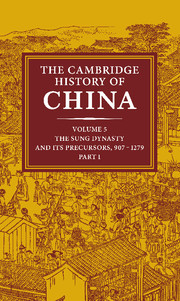Book contents
- Frontmatter
- Introduction: the Sung Dynasty and Its Precursors, 907–1279
- 1 The Five Dynasties
- 2 The Southern Kingdoms between the T’ang and the Sung, 907–979
- 3 Founding and Consolidation of the Sung Dynasty under T’ai-tsu (960–976), T’ai-tsung (976–997), and Chen-tsung (997–1022)
- 4 The Reigns of Jen-tsung (1022–1063) and Ying-tsung (1063–1067)
- 5 Shen-tsung’s Reign and the New Policies of Wang An-shih, 1067–1085
- 6 Che-tsung’s Reign (1085–1100) and the Age of Faction
- 7 The Reigns of Hui-tsung (1100–1126) and Ch’in-tsung (1126–1127) and the Fall of the Northern Sung
- 8 The Move to the South and the Reign of Kao-tsung (1127–1162)
- 9 The Reign of Hsiao-tsung (1162–1189)
- 10 The Reigns of Kuang-tsung (1189–1194) and Ning-tsung (1194–1224)
- 11 The Reign of Li-tsung (1224–1264)
- 12 The Reign of Tu-tsung (1264–1274) and His Successors to 1279
- Bibliography
- Glossary–Index
Introduction: the Sung Dynasty and Its Precursors, 907–1279
Published online by Cambridge University Press: 28 March 2010
- Frontmatter
- Introduction: the Sung Dynasty and Its Precursors, 907–1279
- 1 The Five Dynasties
- 2 The Southern Kingdoms between the T’ang and the Sung, 907–979
- 3 Founding and Consolidation of the Sung Dynasty under T’ai-tsu (960–976), T’ai-tsung (976–997), and Chen-tsung (997–1022)
- 4 The Reigns of Jen-tsung (1022–1063) and Ying-tsung (1063–1067)
- 5 Shen-tsung’s Reign and the New Policies of Wang An-shih, 1067–1085
- 6 Che-tsung’s Reign (1085–1100) and the Age of Faction
- 7 The Reigns of Hui-tsung (1100–1126) and Ch’in-tsung (1126–1127) and the Fall of the Northern Sung
- 8 The Move to the South and the Reign of Kao-tsung (1127–1162)
- 9 The Reign of Hsiao-tsung (1162–1189)
- 10 The Reigns of Kuang-tsung (1189–1194) and Ning-tsung (1194–1224)
- 11 The Reign of Li-tsung (1224–1264)
- 12 The Reign of Tu-tsung (1264–1274) and His Successors to 1279
- Bibliography
- Glossary–Index
Summary
Introduction
We present here the first of two volumes on the Sung dynasty (960–1279) and its Five Dynasties (907–60) and Ten Kingdoms (c. 907–79) predecessors. Whereas our companion volume (Volume 5, Part 2) takes a thematic approach to Sung institutional, social, economic, and cultural history, our task here is to present the political history of China from the fall of the T’ang dynasty in 907 to the Mongol conquest of the Southern Sung in 1279. Because our focus is on political events as seen from the perspective of the Sung court, we recommend that this volume be read in conjunction with The Cambridge history of China, volume 6: Alien regimes and border states, 907–1368, which covers the same period and many of the same events from the vantage point of the non-Chinese regimes and border states that had so momentous an impact on China in this multistate era of the tenth through the thirteenth centuries. This overview will offer a brief introduction to the intersection of political trends and Sino-steppe encounters during the Five Dynasties and Northern and Southern Sung that are portrayed in the chapters to follow.
coming out of the t’ang: state building in north and south
The collapse of T’ang power in the final decades of the ninth century unleashed massive forces of rebellion, warlordism, and territorial fragmentation, giving way to what traditional narratives depict as a half century of political division and social turmoil before the reestablishment of unity and order by Chao K’uang-yin and his new dynasty, the Sung (960–1279). The social turmoil was powerful enough to sweep away the underpinnings of the old T’ang aristocracy and usher in new social and political elites.
- Type
- Chapter
- Information
- The Cambridge History of China , pp. 1 - 37Publisher: Cambridge University PressPrint publication year: 2009
- 6
- Cited by



